Twigs and Branches - 2022 June to August.
A web of present and past events
These short articles are written to highlight connections of the plants, history and lore of the Eloise Butler Wildflower Garden with different time frames or outside connections. A web of intersections.
A vaccine for Poison Ivy - August 2022

Been bothered by Poison Ivy? Tried various remedies? What if there was a vaccine, not to prevent exposure, but to prevent the itch, scratch and rash? It’s coming.
The University of Mississippi has been granted its fourth patent for a product that could prevent the itching and rash resulting from exposure to urushiol from Poison Ivy, Poison Oak and Poison Sumac. It was long thought that the immune system’s T-cells caused the rash and itch. But recent research has shown that while T-cells are involved with the inflammation, a different mechanism triggers the itch. A chemical released by skin cells, inter-leukin 33, acts on sensory neurons in the skin causing the itch.
Eighty-five percent of the U.S. population is sensitive to urushiol, with itchy attacks usually coming after the second exposure as sensitivity to it builds up with each exposure.
The new chemical compound, which contains derivatives of urushiol, would be injected like a flu shot and be good for one or two years. For those that work in the outdoors a lot, this could be game-changing.
Fact sheet on the Poison Ivy Plant.
Fountains in the Garden - August 2022
Have you drank from the three fountains in the Wildflower Garden? All three are of identical limestone construction and are memorials with a connection to the Garden and the Friends. Drinking fountains had to wait until a water supply was run to the Garden which did not happen until 1947, into the upper garden and not until 1964 down to the lower garden. Thus the oldest of the three is from 1971.
Nordquist Fountain.


Burgess Fountain.

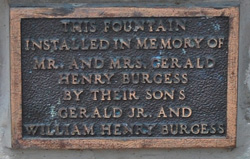
Louise had organized and counseled family-life groups in Minneapolis more than forty years and wrote a column entitled "Let's Be Better" for the Edina Courier from 1950 to 1960. She was also an author, her first book being This side of the stars, which was mentioned in The Fringed Gentian™ Vol. 6 No. 3., in July 1958. Louise had gifted the cost in 1970 of the original book of memorials that was displayed in the Martha Crone Shelter after it was dedicated. This book had a fancy custom made cover with pages that were hole-punched for insertion after they were engraved. The book was made by Mr. Otto Japs of Japs-Olson Printing and he engraved the pages, which were divided into two sections of the book. One section for the donors to the building of the Crone Shelter and one section for other memorials. The book was stolen from the shelter in later years.
Her husband, Gerald H. Burgess, had passed away suddenly on April 29 1938. He was the owner of the Panama Carbon Company in Minneapolis and was the donor of a number of plants in the early 1930's when Martha Crone was curator. He and Gertrude Cram visited Martha Crone in the Garden on July 13, 1933 and in the summer of 1934 he provided some Azure Bluets, (Houstonia caerulea); Yellow Corydalis (yellow fumewort), (Corydalis flavula); Walking Fern (Asplenium rhizophyllum); Hay-Scented Fern; (Dicksonia punctilobula; Marginal Wood Fern (Dryopteris marginalis) and Christmas Fern (Polystichum acrostichoides). Some of these species were new to the Garden. In 1939 Martha received a donation of 100 Hay-scented ferns (Dennstaedtia punctilobula) in his memory.
Witt Fountain.
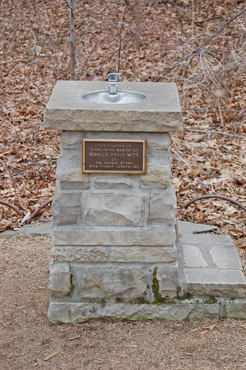

The Garden in late August
There is color aplenty in the August Garden - in the wetland and in the upland.
A exploration on the boardwalk through the heart of the wetland this week reveals multiple displays of Cardinal Flower, Spotted Jewelweed, Boneset, Spotted Joe-Pye Weed (see our separate article), Obedient Plant (False Dragonhead), and Flat-topped Aster. Look for the Swamp Thistle and the Blue (or Sw2amp) Vervain.
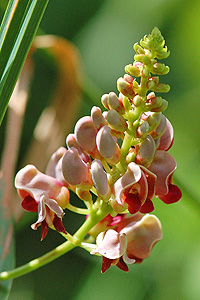
Spot the Groundnut near the gathering area. History repeats here. You could usually find this vining plant in the sunny upland but with the elimination of overhead canopy of the now-removed green ash in the wetland, Groundnut has found an opportunity. Almost 50 years ago the same thing occurred when the canopy of American Elm was eliminated. Gardener Ken Avery was pictured in an August 29, 1978 newspaper article showing a Groundnut, a plant he said “not found in the forest area of the Garden until the canopy of elm was eliminated.”
If you don’t know what the parasitic vine Dodder looks like, you can see a display of it in the wetland next to the boardwalk- its signed. There are a number of Dodder species, each tending to certain plants. Cuscuta gronovii likes the wetland. When you go up to the upland, you see a large scale grouping of another dodder, Cuscuta glomerata, hosting on Goldenrod.
In the upland, the large numbers of sunflowers and coneflowers appear hight-challenged along side the two tall Silphiums - Cup Plant and Prairie Dock - you can’t miss them. Eloise Butler had no success making Prairie Dock to grow for her until she hit upon a solution. Read that story here. The upland also gives you the opportunity to visually compare the Spotted Joe-pye Weed with the Sweet Scented Joe-pye weed as both are represented there. (See separate article about them.)
Below: Bigleaf Aster (Eurybia macrophylla) in bloom in the upland in late August. This aster is found in both the upland and woodland and is one of the first asters to bloom.

The Joe-Pye Weeds
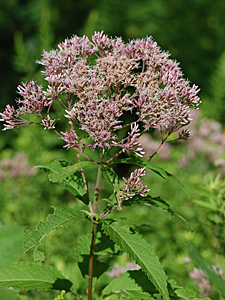
Among the medicinal plants sent back to the Old World by North American explorers were the five species commonly called Joe-Pye Weeds. Two are found in Minnesota and in the Butler Wildflower Garden. They were once a part of a large medicinal genus of plants of the genus Eupatorium, well known in the Old World. Now, the Joe-Pye Weeds have been assigned their own genus, Eutrochium, in 2004, of which there are just the five members in North American.
The Spotted Joe-Pye Weed, (E. maculatum) predominates in the wetland and Sweet Scented Joe-Pye Weed (E. purpureum), which is indigenous to the Garden, prefers the upland, but you will find the Spotted there also for easy comparison. The plant root produces a working compound called Euparin with the chemical formula C12-H11-O3. The root was used primarily as a diuretic and for internal ailments and the leaves for a tea that could break a fever.
The use of crushed leaves of Sweet Scented were said to improve the complexion and one interesting legend has it that a young brave courting a young women was “assured” of success if he stuck a wad of the leaves in his mouth before he went visiting. Perhaps it had mouthwash effects as the leaves of the Sweet Scented have a vanilla scent when crushed.
Our photos show the differences in the coloration of the flowers and of the stem. As members of the Aster family, the flower heads are composites and another difference is that Spotted has 9 to 20 little florets per head, whereas Sweet-Scented has only 4 to 7. The leaves of both form whorls on the stem, which does not branch below the inflorescence.
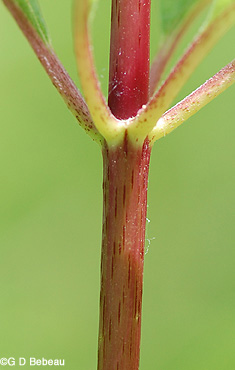
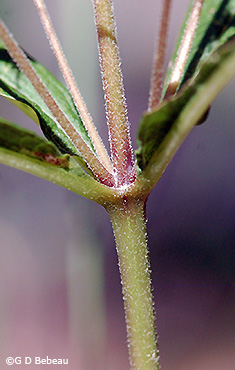
Use our fact sheets for more identification detail, medicinal uses, and history of the name, which goes all the way back to king Mithridates Eupator, the ruler of Pontus in old Asia Minor, who lived from 135-63 BC. This is the man who sought immunity to poisons.
Fact Sheets.
Below: A stand of Spotted Joe-Pye Weed in the Upland. Note the darker flower color and the dark stems.
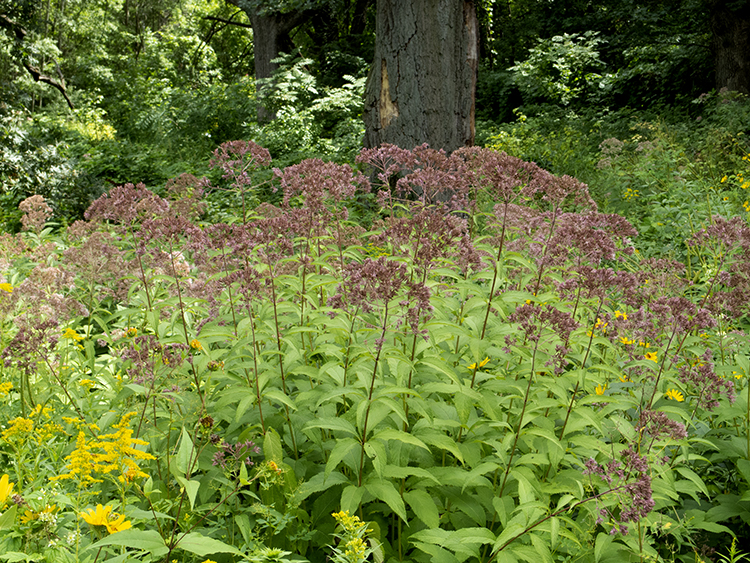
Friends Annual Meeting
The Annual Meeting of the Friends of the Wild Flower Garden will be held on the afternoon of September 18, 2022.
Our guest speaker will be Dr. Lee Frelick, Director of the University of Minnesota Center for Forest Ecology. Susan Wilkins, Curator of the Garden, will speak also.
The meeting will have live attendance and Zoom links. Details of time and place will be on our website at the end of August and will be send via email at the same time.
When September comes don't forget to take walk in the Garden, or Wirth Park or any woods and reflect on the words of William Cullen Bryant:
I roam the woods that crown
The upland, where the mingled splendours glow,
Where the gay company of trees look down
On the green fields below.
My steps are not alone
In these bright walks; the sweet south-west, at play,
Flies, rustling, where the painted leaves are strown
Along the winding way.
Rusty Patched Bumblebee - July 2022
By the year 2000 the Rusty Patched Bee (Bombus affinis) disappeared across its entire range, then a decade later began to reappear around urban centers. Today there are 90% fewer bees than in the last century coinciding with a 95% reduction in habitat. For reasons yet unknown, more of these bees have been recently counted in Minnesota than anywhere else. One was sighted in the Eloise Butler Wildflower Garden in August 2020. The Rusty Patched entered Federal endangered status in 2017, it was selected as the Minnesota state bee in 2019.

Above: The Rusty Patched Bumblebee. Photo Heather Holm, University of Minnesota.
They nest in the ground and in cavities. The males and workers have two distinguishing identifying marks:
1. There is a T-shaped area of black hairs on the thorax and
2. There is a rusty colored patch in the middle of the 2nd abdominal segment.
The Queens have different identifying marks and they usually lack the rusty patch.
The University of Minnesota Extension Division, particularly via etymologist Elaine Evans, has led research into the life of this bee. You can view that work at https://extension.umn.edu/yard-and-garden-news/rusty-patched-bumble-bee. Also on that site is a video describing how to identify the queens.
If you have an interest in helping research you can take part in the inaturalist 4th annual Backyard Bumble Bee Count that runs July 24 to August 2. You can access that from the same University page.
Below: Thanks to the University of Minnesota Extension for the use of their Identifying Chart.
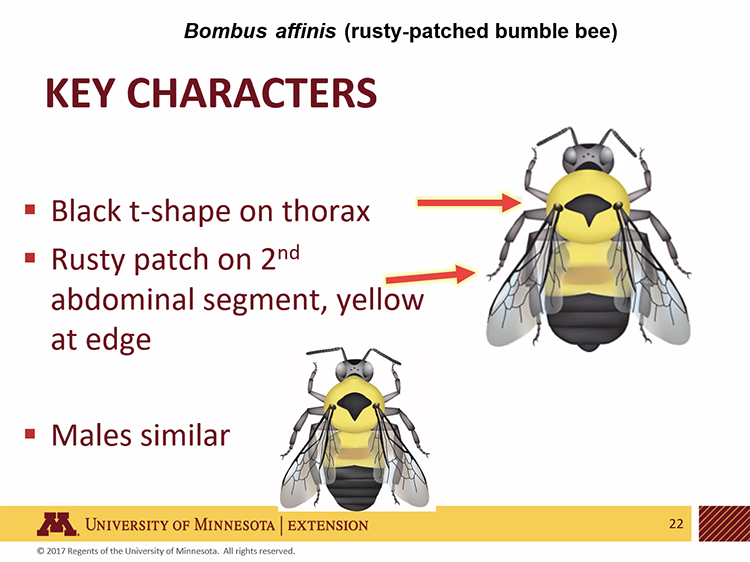
The record heat wave of July 1936
For a year that started out with extreme cold, 36 consecutive days of sub-zero minimums including one day of -34 F in January, there was no indication of the historic high temperatures to be reached six months later. Early March had 16 inches of snow depth on the ground; the last snow storm on April 6th brought 2-½ inches of new snow and the last snow in the Garden did not melt until April 16th. It was a lingering spring like 2022. The Showy lady’s-slippers dd not bloom until the summer solstice, the second latest date ever. But on June 14 the rains stopped, temperatures rose.

July 1936 would become the hottest July in local recorded weather history with the highest temperature in Twin Cities recorded weather history of 107.8 degrees on July 14th. Altogether there were 14 days of temperatures at 100 degrees and above during July. Garden Curator Martha Crone planted a few species but she noted on July 28th that everything was dried up and yet it would be another 18 days before it would rain. Finally on August 15 she wrote “½ inch of rain after a lapse of 60 days.” By August 16th she noted the first migrating warblers coming through the Garden.
She wrote in her annual report to Parks Superintendent C. A. Bossen “In spite of the heat and drought no trees were lost, due largely to the heavy accumulation of leaves covering the ground; thereby increasing absorption of rainfall and holding vast amounts of water and slowing up the run-off, also preventing erosion of the soil.”
Despite the drought, it was not the driest year on record - that record still belongs to 1910.
The two queens of Summer in the Wildflower Garden
In the wetland at Eloise Butler reside the two queens that bloom around the same time. From a distance the inflorescence looks like a filmy cloud of bloom - white in the case of Queen of the Meadow (Filipendula ulmaria) and pink for the Queen of the Prairie (Filipendula rubra). The former is at home in the wetland making numerous appearances along the boardwalk whereas the latter is reclusive there but is also more adaptable to an upland meadow habitat if you care to plant it in a home garden. Both were in bloom this past week.
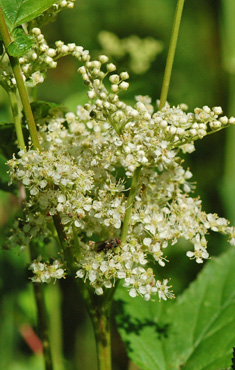
Neither are native to our area but have been in the Garden as early as 1933/34 for ulmaria and much later for rubra. Both need a lot of sun to flower nicely, but ulmaria needs more soil moisture, hence its proliferation in the wetland. It seeds nicely but behaves, whereas rubra has an aggressive root system so beware where you plant as it will spread. Ulmaria has fragrance whereas rubra has none, but both draw pollinators to the pollen.
Besides the stately height of ulmaria and the lovely bloom, it has a number of medicinal claims to fame. It is a plant that provided Salicylic acid, a key chemical for making acetylsalicylic acid (aspirin) which was first obtained from the flowers in 1839 in Germany. Willow bark of course, had long been known to contain the chemical. These salicylates are the basis for the plants long-standing reputation as a remedy for flu, rheumatism, arthritis, as a diuretic, and for fevers, not to mention the fragrant almond aroma of the flowers for which Queen Elizabeth I is said to have used them to strew the floors of her chambers.
Various names have been given to these plants over the years and they used to be in the genus Spiraea but molecular research shows they belong in Filipendula. Another plant called Meadow Sweet, Spiraea alba, is sometimes confused with ulmaria, but that plant lacks the medicinal and folk history.


More detail on the plants, more photos, and a lot of historical medicinal uses and source information are found in our informations sheets.
July Garden Hi-lights.
The list of species in bloom at this point of the year is a long one so let us mention here just a few on view now. The two Queens are hi-lighted in another article this month. You could concentrate on viewing plants with established medicinal values - from folk times to modern days, many once had listings in the U.S. Pharmacopoeia and in the NF (National Drug Formulary) - among the most important you will see in bloom are Culver's Root (prolific this year), Purple Coneflower, both St. Johnsworts, Prairie Dogbane, Spreading Dogbane, both Joe-pye Weeds, Bugbane and Wild Bergamot. Details about each plant are on our plant information sheets - look up the name here.

For the children, you can introduce them to a grass whose name they may never forget - Bottlebrush Grass. See it near the Baker bench in the east woodland and in many places in the upland. Coming up - if you are unfamiliar with Jewellweed, a visit will inform you, as there is an explosion of it this year in the wetland and surrounding trails. It will be blooming in the very near future.
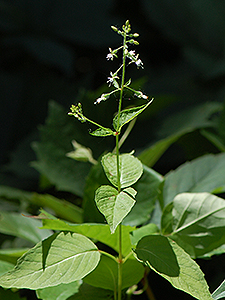
For a lesser known often overlooked plant, you will see many examples in the woodland and shady areas of the upland, of the Enchanter's Nightshade (Circaea lutetiana), with its diminuative two-petaled flowers on a spike rising above the leaves. Many dog-owners dislike it around the home as the flowers produce burs, but you should get to know it as it is an ancient plant, found in the old world and the new. The genus Circaea, is named after Circe, the enchantress of the old classics. The species lutetiana, is derived from the old Latin name for the city of Paris, which ment "witch city." Sounds enchanting, doesn't it, but John Gerard wrote (Herbal, 1597) that it was all a mistake that keeps perpetuating itself - attributing to Circaea the qualities of another genus - Mandragoras.
P.S. Our summer Fringed Gentian™ mystery plant was still in bloom in the upland this past week.
Below: A group of Culver's Root in the upland.
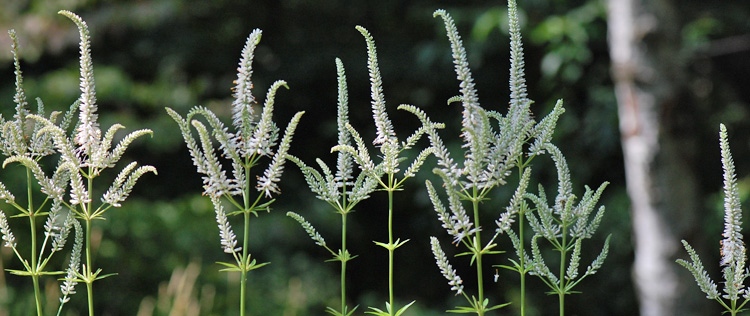
The Leatherwood and Eloise Butler’s Memorial Tablet
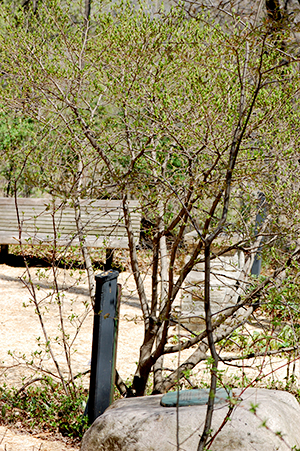
One is no more; one may be slowly disappearing!
When the Memorial Tablet for Eloise Butler was dedicated in 1934 a Pin Oak was planted near it as the tree was a favorite of Eloise from her east coast years - it had been introduced into Maine where she lived her first 22 years. The Pin Oak (Quercus palustris), not native to Minnesota, did not last long. Re-plantings did not either - wrong habitat - but a Leatherwood shrub, (Dirca palustris) planted sometime after the completion of the Martha Crone Shelter in 1970, survived until rot set in at the base a few years ago. A section of the trunk broke off and the remainder was not deemed salvageable so now the Tablet-sheltering shrub, with its soft lemon-yellow flowers in early spring, is gone, although a younger one remains closer to the building and a very young one at the path to the Shelter.
Leatherwood near the Tablet was appropriate as Eloise had introduced the species to the Garden in 1912 and had written about her occult experiences in finding one to transplant in her history Annals of the Wild Life Reserve.
The boulder holding the Tablet is, however, slowly being subsumed into the earth, much like the 1917 birdbath or the Sphinx of ancient Egypt. No sand here, but just the natural process of soil movement. It will not disappear in our lifetime, but use the photos for a comparison of the boulder’s position now vs 1934.
Below: 1st photo - the Memorial Tablet Boulder after the demise of the Leatherwood shrub - 2022. Compare the boulder position in the second photo on May 4, 1934, the day of dedication. [photo Friends archive at MHS].
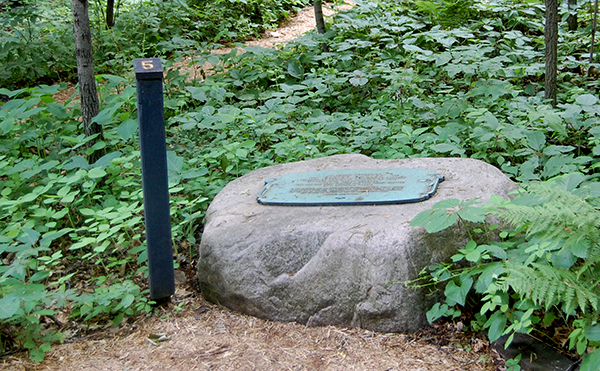
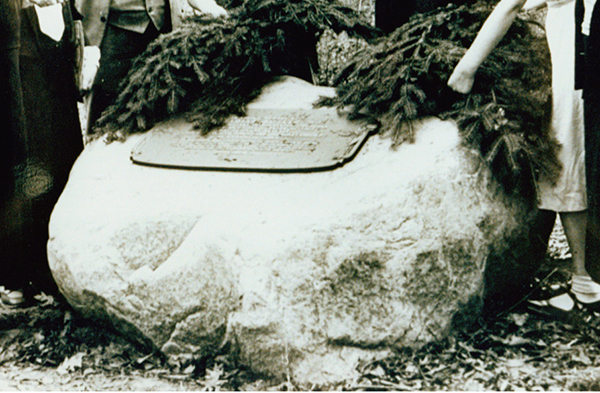
White Strawberries
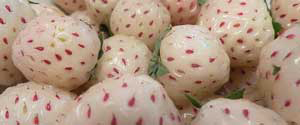
Yes, you can buy white strawberries. Some species never turn red, although fully ripe. Some will grow in Minnesota. But among folks whose strawberries must be red, they are probably not sought out much even though they taste the same.
All strawberries are white at mid-point in their maturity cycle - first pea size green, then through a white stage, finally turning red. Recent research in sequencing the genome of a number of strawberry species has uncovered the gene that makes strawberries red, or white when it is lacking. Some species, such as our native Woodland Strawberry, Fragaria vesca, can have a mutation, particularly in the gene MYB10 that causes an amino acid change that keeps the berry white. For the technically inclined, here is a link to a research article.
Below: The native Woodland Strawberry, Fragaria vesca, shown with a berry in the white stage and the mature red berry stage.
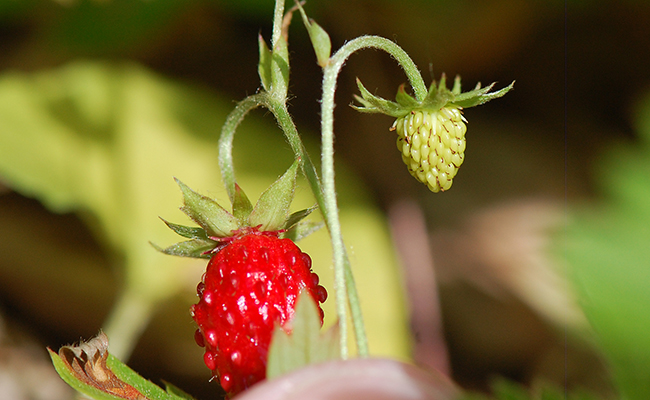
White flowers for summer.
Eloise Butler wrote in 1911 “To subdue the brilliant orange and reds of the lilies and composites, Mother Nature has planted among them with judicious and generous hand various white flowers.” to that sentiment Martha Crone added “The dainty spring flowers have long since passed and the deeper colors of summer flowers are now noted. Mingled with these are a number of white flowers all too little appreciated. They give us a source of light and restfulness, and serve to intensify the brilliant colors. In nature no colors clash.”
Our feature article highlights a number of the white natives that you can see at Eloise Butler and perhaps, grow in your native garden.
Founding of the Friends - 70 years ago.
On June 18th Articles of Incorporation were filled with the State of Minnesota for Friends of the Wild Flower Garden, Inc., a non-profit group formed for the purposes of advancing, promoting and furthering the interests of the Municipal Wild Flower Garden in Theodore Wirth Park conducted by the Board of Park Commissioners of the City of Minneapolis. The formation of the group was announced in the Minneapolis Star on June 27.
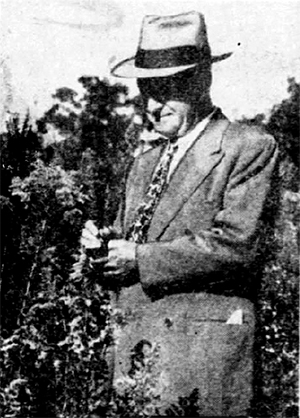
The founding directors were Clinton M. Odell, Russell H. Bennett, Dorothy Binder, Martha E. Crone, Donald C. Dayton, Leonard F. Ramberg.
Clinton Odell was a student of Eloise Butler and a frequent visitor to the Wild Flower Garden. When Martha Crone became curator he provided assistance to her in the Garden and financial gifts to the Board of Park Commissioners to help develop the Garden. He felt it imperative there always be a group of citizens who would work for the best interests of the Garden. He was concerned the Garden could become expendable if the Park Board had to cut costs.
The Minneapolis Tribune noted on May 12, 1949:
The well-dressed man whom visitors to the Eloise Butler Wild Flower Garden in Minneapolis see pulling weeds every week-end except in the dead of winter is not the superintendent of parks. Five days a week he is the chairman of the board of the shaving cream company which adorns the roadside with jingles designed to discourage traffic accidents and encourage shavers to remove their whiskers with his products. While fellow businessmen are out digging holes in the turf on their favorite links, Odell is digging holes to plant some choice specimen just received from a distant part of the country.
Odell's full story is found in this article: Clinton Odell.
The background of the other directors is: Russell H. Bennett was Chairman of the Board of Dunwoody Institute; Dorothy Binder was a Twin Cities journalist; Donald C. Dayton was President of the Dayton Company; Leonard F Ramberg was affiliated with the American Swedish Institute and Augsburg College where he was later Chairman of the Board of Regents. Link to biographical details on those four directors.
Clinton Odell wrote letters to many of his business acquaintances inviting them to become a member of The Friends. Martha Crone, as membership secretary, wrote many more. By October 1953 there were 162 members.
The Garden in late June
On June 16 the Showy Lady’s-slippers were in full bloom. There may be a bloom remaining by the time you receive this. Elsewhere along the boardwalk there were Wild Calla, Blue Flag and Forget-me-not.
Below: Showy Lady's-slippers in bloom on June 18, 2022. Photo G D Bebeau.

It’s a bursting-out story in the upland part of the Garden. You will find no fewer than 30 wild flowers in bloom in you just concentrate around the west loop path and the lone oak hill. On the 16th White and Blue False Indigos, Horse Gentian and Northern Bedstraw were abundant and in full bloom.
A few of the more elusive to spot: Northern Bush Honeysuckle, Wild Four-o’clock, Bracted Spiderwort and Wild Garlic. If you have our Plant ID book you are all set, if not, check the links for what to look for.
Others you may see include: Prairie Dogbane, Tall Meadow Rue, American Alumroot, American Vetch, Thimbleweed, Columbine, Yellow Daylily, Yarrow, Bluejacket, Golden Alexanders, Daisy Fleabane, Great Indian Plantain,, Foxglove Beardtongue, Showy Beardtongue, Canada Anemone, Smooth Rose, Arkansas Rose, Tall Buttercup, White Avens, Canada Moonseed.
Below: Heartleaf four-o'clock in the upland Garden. Photo G D Bebeau
